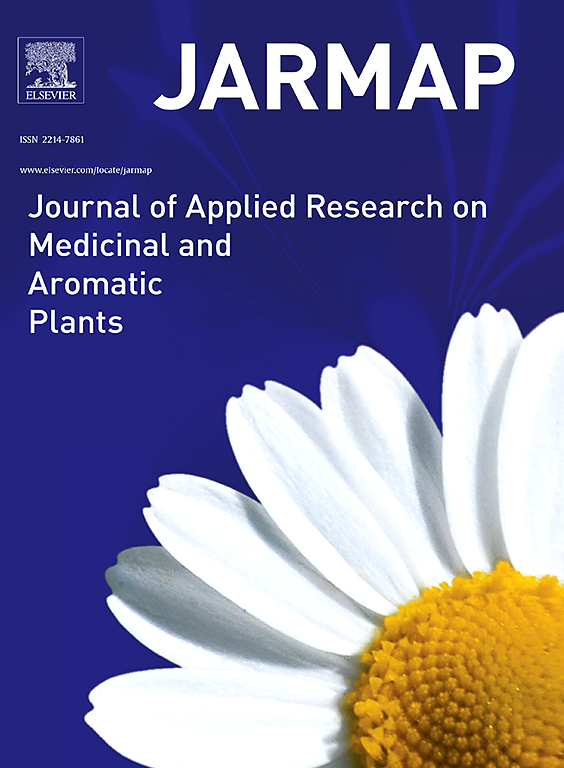三种根茎草本植物中的真菌群落:见解和影响
IF 3.6
2区 农林科学
Q1 PLANT SCIENCES
Journal of Applied Research on Medicinal and Aromatic Plants
Pub Date : 2024-10-04
DOI:10.1016/j.jarmap.2024.100587
引用次数: 0
摘要
黄芪(AM)、薯蓣(DR)和党参(CR)的根茎经常被用于传统滋补配方和膳食补充剂中。由于根茎长期暴露在复杂的生物环境中,因此有必要研究其表面的真菌组成。在本研究中,我们通过 DNA 代谢编码分析了三种根茎药材中的真菌群落,并对每个分类级别的真菌多样性进行了广泛比较。此外,我们还研究了物种、采集地点和加工方法对真菌群落的影响。在黄芪和党参样本中,担子菌是主要的真菌属,相对丰度分别为 1.98 %-76.81 % 和 1.69 %-85.59 %。曲霉属(0.08 %-99.92 %)是薯蓣根茎样本中的主要菌属。同时,共鉴定出 12 种潜在的致毒真菌,包括限制曲霉、氧孢镰刀菌和柠檬青霉。此外,还观察到不同采集地点和处理方法的真菌多样性和群落组成存在差异。线性判别分析效应大小表明,三种根茎类药材的菌属相对丰度存在显著差异。Gibberella 属和 Mucor 属在黄芪样品中明显富集,而 Yarrowia 属和 Cladosporium 属分别在薯蓣根茎和党参样品中明显富集(p≤0.001)。本研究对三种根茎类药材的真菌特征提出了新的见解,从而为其安全利用和质量改进提供了参考。本文章由计算机程序翻译,如有差异,请以英文原文为准。
Fungal communities in three root herbs: Insights and implications
The roots of Astragali Radix (AM), Dioscoreae Rhizome (DR), and Codonopsis Radix (CR) are frequently used in classical tonic formulations and dietary supplements. Given the extended exposure of rhizomes to complex biological environments, it is necessary to investigate the fungal composition of their surface. In this study, the fungal communities in the three root herbs were analyzed by DNA metabarcoding, and an extensive comparison of the fungal diversity at each taxonomic level was carried out. Furthermore, we examined the effects of species, collection site, and processing method on the fungal community. In Astragali Radix and Codonopsis Radix samples, Cladosporium was the predominant genus, with relative abundances of 1.98 %-76.81 % and 1.69 %-85.59 %, respectively. Aspergillus (0.08 %–99.92 %) was the prevailing genus in Dioscoreae Rhizome samples. Meanwhile, a total of 12 potential toxigenic fungi were identified, including Aspergillus restrictus, Fusarium oxysporum, and Penicillium citrinum. Moreover, the variations in fungal diversity and community composition from different collection sites and processing approaches were observed. Linear discriminant analysis effect size indicated significant differences in the relative abundance of genera among the three root herbs. Gibberella and Mucor genera were significantly enriched in Astragali Radix samples, while Yarrowia and Cladosporium genera exhibited significant enrichment in Dioscoreae Rhizome and Codonopsis Radix samples, respectively (p≤0.001). This study presents novel insights into the fungal profiles of three root herbs, thereby providing references for their safe utilization and quality improvement.
求助全文
通过发布文献求助,成功后即可免费获取论文全文。
去求助
来源期刊

Journal of Applied Research on Medicinal and Aromatic Plants
Pharmacology, Toxicology and Pharmaceutics-Drug Discovery
CiteScore
6.40
自引率
7.70%
发文量
80
审稿时长
41 days
期刊介绍:
JARMAP is a peer reviewed and multidisciplinary communication platform, covering all aspects of the raw material supply chain of medicinal and aromatic plants. JARMAP aims to improve production of tailor made commodities by addressing the various requirements of manufacturers of herbal medicines, herbal teas, seasoning herbs, food and feed supplements and cosmetics. JARMAP covers research on genetic resources, breeding, wild-collection, domestication, propagation, cultivation, phytopathology and plant protection, mechanization, conservation, processing, quality assurance, analytics and economics. JARMAP publishes reviews, original research articles and short communications related to research.
 求助内容:
求助内容: 应助结果提醒方式:
应助结果提醒方式:


